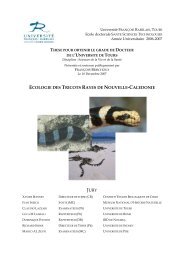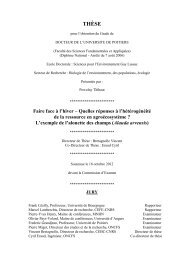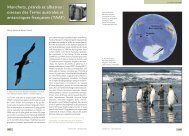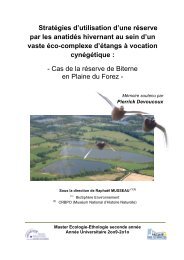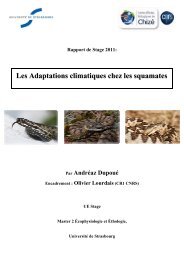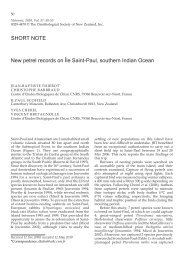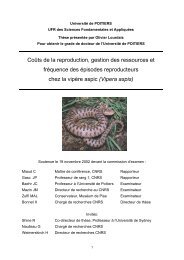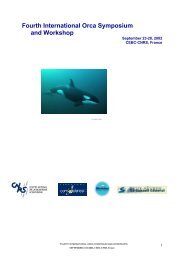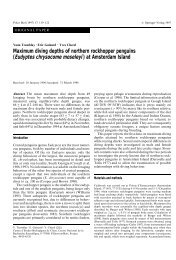Forçage environnemental et prédateurs marins ... - Cebc - CNRS
Forçage environnemental et prédateurs marins ... - Cebc - CNRS
Forçage environnemental et prédateurs marins ... - Cebc - CNRS
Create successful ePaper yourself
Turn your PDF publications into a flip-book with our unique Google optimized e-Paper software.
survival rates and the population dynamics of a marine<br />
top predator. The strength of density dependence was<br />
affected by climate. At low population densities, winter<br />
survival decreases when climatic conditions become<br />
unfavourable (negative SOI values and warm sea-surface<br />
temperatures), but remains sufficiently high (ca. 0.925) to<br />
avoid major population declines (l = 0.992, based on a<br />
matrix population model (Caswell 2001) with seven age<br />
classes (age at first reproduction 4 years, juvenile survival<br />
rate 0.5, immature survival rate 0.88, fecundity 0.4)).<br />
When condition d<strong>et</strong>eriorates at high population densities,<br />
winter survival declines dramatically through densitydependent<br />
effects (down to 0.865) and population crashes<br />
occur (l = 0.914). Such combined effects have not, to our<br />
knowledge, previously been reported for a marine top<br />
predator. This suggests that both density and climatic<br />
fluctuations may affect populations in marine systems, as<br />
has been previously shown for terrestrial systems (Leirs <strong>et</strong><br />
al. 1997; Coulson <strong>et</strong> al. 2001).<br />
Comp<strong>et</strong>ition acting mainly through lower food availability<br />
at sea during winter in the Southern Ocean<br />
(Comiso <strong>et</strong> al. 1993; Daly & Smith 1993; Moore & Abbott<br />
2000) may be the mechanism leading to the association<br />
b<strong>et</strong>ween survival rates and density. Blue p<strong>et</strong>rels may have<br />
to comp<strong>et</strong>e for food resources with conspecifics or with<br />
individuals from species showing overlap in the resource<br />
needs such as Pachyptila sp. (Cherel <strong>et</strong> al. 2002). Warm<br />
sea-surface temperatures off Kerguelen in the winter<br />
are known to negatively affect zooplankton communities<br />
(Pakhomov & McQuaid 1996) and the body condition of<br />
blue p<strong>et</strong>rels (Guin<strong>et</strong> <strong>et</strong> al. 1998). Blue p<strong>et</strong>rels mainly forage<br />
on prey species living south of Kerguelen (ex: Themisto<br />
gaudichaudii and Euphasia superba (Cherel <strong>et</strong> al. 2002)),<br />
whose abundance is negatively affected by warm sea-surface<br />
temperatures (Marinovic <strong>et</strong> al. 2002). Our results<br />
thus suggest that survival variability may be mainly driven<br />
by abundance of resources.<br />
Summer survival was relatively high and varied little<br />
b<strong>et</strong>ween years. This result seems surprising because, as<br />
estimated, summer survival includes the costs of breeding<br />
and moulting. This is probably because breeding and<br />
moulting occur during a period when primary (phytoplankton)<br />
and secondary (zooplankton) productivities in<br />
the southern Indian Ocean are high (Daly & Smith 1993;<br />
Moore & Abbott 2000). In addition, the effect of the<br />
reproductive effort made during the summer might only<br />
appear during winter. For example, a late moult or a<br />
demanding breeding might result in a poor preparation for<br />
the winter and its subsequent effect on mortality. Thus,<br />
winter survival was the main d<strong>et</strong>erminant of annual survival.<br />
Although this is a common assumption in ecology,<br />
it has never been explicitly estimated previously for such<br />
a long-lived organism.<br />
The study period was characterized by the occurrence<br />
of an exceptionally long-lasting warming of the southern<br />
Indian Ocean (1994–1997) corresponding (with a lag) to<br />
the longest record of successive negative SOI values<br />
(McPhaden 1993), that had probably profound effects on<br />
all components of the marine ecosystem ( Jaksic 2001).<br />
The blue p<strong>et</strong>rel population decreased dramatically following<br />
this long warming event. Our results suggest that<br />
populations of marine top predators are able to sustain<br />
short-term anomalous climatic events (for example by not<br />
Proc. R. Soc. Lond. B (2003)<br />
Population dynamics in a marine top predator C. Barbraud and H. Weimerskirch 2115<br />
breeding), but that long-lasting anomalies result in population<br />
crashes (see also Barbraud & Weimerskirch 2001).<br />
Probably, a chronic increase in sea-surface temperatures<br />
of the Southern Ocean would result in a population<br />
decrease of blue p<strong>et</strong>rels but also in other marine top predators.<br />
Special thanks to all the fieldworkers involved on Mayes Island<br />
in the monitoring programme of blue p<strong>et</strong>rels. We thank Y.<br />
Cherel, O. Chastel, P. M. Thompson, N. C. Stens<strong>et</strong>h, and two<br />
anonymous referees for helpful comments on the manuscript,<br />
and D. Besson for data processing. This study was supported<br />
by the Institut Paul Emile Victor and by the Terres Australes<br />
<strong>et</strong> Antarctiques Françaises.<br />
REFERENCES<br />
Barbraud, C. & Weimerskirch, H. 2001 Emperor penguins and<br />
climate change. Nature 411, 183–186.<br />
Burnham, K. P. & Anderson, D. R. 2002 Model selection and<br />
multimodel inference. New York: Springer.<br />
Burnham, K. P., Anderson, D. R. & White, G. C. 1987 Design<br />
and analysis m<strong>et</strong>hods for fish survival experiments based on<br />
release–recapture. Am. Fish. Soc. Monogr. 5, 1–437.<br />
Caswell, H. 2001 Matrix population models. Sunderland, MA:<br />
Sinauer.<br />
Chastel, O., Weimerskirch, H. & Jouventin, P. 1995 Body condition<br />
and seabird reproductive performance: a study of<br />
three p<strong>et</strong>rel species. Ecology 76, 2240–2246.<br />
Cherel, Y., Bocher, P., Trouvé, C. & Weimerskirch, H. 2002<br />
Di<strong>et</strong> and feeding ecology of blue p<strong>et</strong>rels Halobaena caerulea<br />
at Iles Kerguelen, Southern Indian Ocean. Mar. Ecol. Prog.<br />
Ser. 228, 283–299.<br />
Comiso, J. C., McClain, C. R., Sullivan, C. W., Ryan, J. P. &<br />
Leonard, C. L. 1993 Costal zone color scanner pigment<br />
concentrations in the southern ocean and relationships to<br />
geophysical surface features. J. Geophys. Res. 98, 2419–2451.<br />
Coulson, T., Catchpole, E. A., Albon, S. D., Morgan, B. J. T.,<br />
Pemberton, J. M., Clutton-Brock, T. H., Crawley, M. J. &<br />
Grenfell, B. T. 2001 Age, sex, density, winter weather, and<br />
population crashes in Soay sheep. Science 292, 1528–1531.<br />
Daly, K. L. & Smith, W. O. 1993 Physical–biological interactions<br />
influencing marine plankton production. A. Rev. Ecol.<br />
Syst. 24, 555–585.<br />
Forchhammer, M. C., Stens<strong>et</strong>h, N. C., Post, E. & Langvatn,<br />
R. 1998 Population dynamics of Norwegian red deer: density-dependence<br />
and climatic variation. Proc. R. Soc. Lond.<br />
B 265, 341–350. (DOI 10.1098/rspb.1998.0301.)<br />
Fr<strong>et</strong>well, S. D. 1972 Populations in a seasonal environment.<br />
Princ<strong>et</strong>on University Press.<br />
Gauthier, G., Pradel, R., Menu, S. & Lebr<strong>et</strong>on, J.-D. 2001<br />
Seasonal survival of greater snow geese and effect of hunting<br />
under dependence in sighting probability. Ecology 82,<br />
3105–3119.<br />
Grenfell, B. T., Wilson, K., Finkenstadt, B. F., Coulson,<br />
T. N., Murray, S., Albon, S. D., Pemberton, J. M., Clutton-<br />
Brock, T. H. & Crawley, M. J. 1998 Noise and d<strong>et</strong>erminism<br />
in synchronised sheep dynamics. Nature 394, 674–677.<br />
Guin<strong>et</strong>, C., Chastel, O., Koudil, M., Durbec, J.-P. & Jouventin,<br />
P. 1998 Effects of warm sea-surface temperature anomalies<br />
on the blue p<strong>et</strong>rel at the Kerguelen Islands. Proc. R.<br />
Soc. Lond. B 265, 1001–1006. (DOI 10.1098/rspb.1998.<br />
0390.)<br />
Houghton, J. T., Ding, Y., Griggs, D. J., Noguer, M., Van der<br />
Linden, P. J., Dai, X., Maskell, K. & Johnson, C. A. 2001<br />
Climate change 2001: the scientific basis. Cambridge University<br />
Press.



